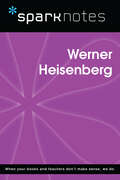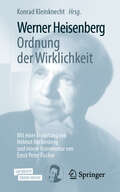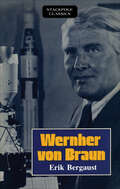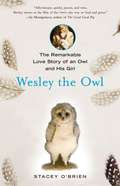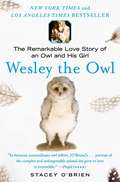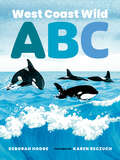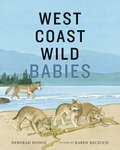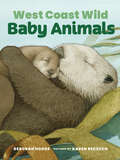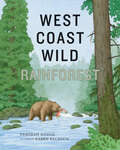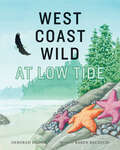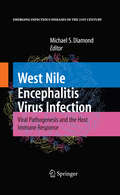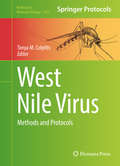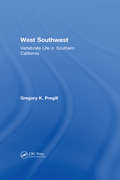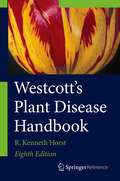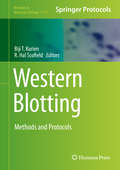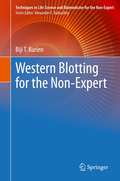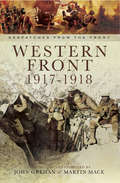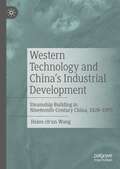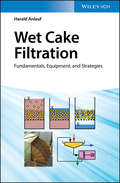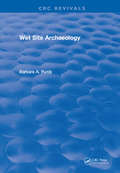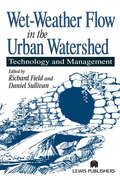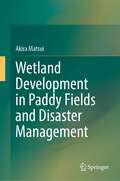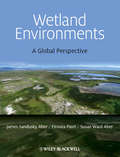- Table View
- List View
Werner Heisenberg (SparkNotes Biography Guide)
by SparkNotesWerner Heisenberg (SparkNotes Biography Guide) Making the reading experience fun! SparkNotes Biography Guides examine the lives of historical luminaries, from Alexander the Great to Virginia Woolf. Each biography guide includes:An examination of the historical context in which the person lived A summary of the person&’s life and achievements A glossary of important terms, people, and events An in-depth look at the key epochs in the person&’s career Study questions and essay topics A review test Suggestions for further reading Whether you&’re a student of history or just a student cramming for a history exam, SparkNotes Biography guides are a reliable, thorough, and readable resource.
Werner Heisenberg, Ordnung der Wirklichkeit: Mit einer Einleitung von Helmut Rechenberg und einem Kommentar von Ernst Peter Fischer
by Konrad KleinknechtWerner Heisenberg schrieb diesen Essay in den Kriegsjahren 1941/42. Er überließ ihn nur Verwandten und ausgewählten Freunden zur Lektüre, dachte aber nicht daran, den Text zu veröffentlichen. In dem Essay zieht Heisenberg eine Summe seiner philosophischen Gedanken über die Natur und über die Frage, wie der Mensch erkennen kann, was die Wirklichkeit ist. Nach Heisenbergs Tod haben die Herausgeber seiner „Gesammelten Werke“ diesen Text nach der Urschrift übernommen und mit dem Titel „Ordnung der Wirklichkeit“ versehen. Er wurde 1989 im Piper Verlag veröffentlicht. Die Heisenberg-Gesellschaft hat beschlossen, Heisenbergs Manuskript neu herauszugeben und mit einer Kommentierung der literarischen, musikalischen, philosophischen und historischen Bezüge zu ergänzen. Die Kommentierung hat dankenswerter Weise Herr Ernst Peter Fischer übernommen.
Wernher von Braun (Stackpole Classics)
by Erik BergaustHere is Dr. Wernher von Braun’s incredible story – from his early years in Germany, where he gave birth to modern rocketry, to his arrival in the United States and his launching of the first American satellite, the first man on the moon and other stunning space exploration feats. “Every page of Wernher von Braun’s life is a monument to the drama of adventure. Few people have been fighting so hard and, indeed, very few have been subject to so much criticism, so much jealousy, so much defeat—yet, very few have lived to be honored and to harvest the fruits of so many wonderful victories as has this man.” Author Erik Bergaust has had the advantage of knowing von Braun as a friend, hunting and fishing companion, space business associate—and biographer—for more than twenty-five years. Thus, he has been able to present a dramatic portrait of an important personality and a 20th century hero.
Weshalb auf die Wissenschaft hören?: Antworten aus Philosophie und wissenschaftlicher Praxis
by Dennis Lehmkuhl Andreas BartelsPandemie und Klimakrise rufen die herausragende Rolle der Wissenschaft und des wissenschaftlichen Wissens für Informierung und Orientierung der Gesellschaft sowie für die Beratung der Politik bei der Ausrichtung praktischer Maßnahmen ins Bewusstsein. In diesem Zusammenhang wird die Frage virulent, weshalb der Wissenschaft diese herausgehobene Rolle zukommt. Dass diese Frage trotz der vielbeschworenen Autorität der Wissenschaft alles andere als trivial ist, zeigt sich daran, dass Wissenschaftsskepsis und Relativierung wissenschaftlicher Resultate bis hin zur Wissenschaftsleugnung Einfluss gewinnen, sobald es um konkrete Fragen der Ausrichtung gesellschaftlichen Handelns an der Wissenschaft geht. Wodurch ist also Vertrauen in die durch die Wissenschaft ermittelten Fakten, die in ihren Modellen entworfenen Szenarien und ihre Ratschläge an Gesellschaft und Politik gerechtfertigt? Weshalb soll man der Wissenschaft in besonderem Maße vertrauen und auf ihren Ratschlag hören?Insgesamt sollen die Beiträge des Buches Aufschluss darüber geben, wodurch die Vertrauenswürdigkeit der Wissenschaft in ihrer modernen Form gerechtfertigt ist und an welche Bedingungen ihre besondere Rolle in der Gesellschaft geknüpft ist. Was kann Wissenschaft für die Gesellschaft leisten und wo liegen die Grenzen ihrer orientierenden Rolle? Was heißt es „auf die Wissenschaft zu hören“ und was sind die Bedingungen dafür, dass Menschen in einer demokratischen Gesellschaft sich wissenschaftliche Erkenntnisse aneignen und sie als Richtschnur für ihr Handeln verwenden?
Wesley the Owl: The Remarkable Love Story of an Owl and His Girl
by Stacey O'BrienStacey O'Brien, a biologist specializing in wild-animal behavior fells in love with and adopts an injured 4 day old barn owl. They spend 19 years together. This true story will delight animal lovers, but may be too real life for kids.
Wesley the Owl: The Remarkable Love Story of an Owl and His Girl
by Stacey O'BrienOn Valentine's Day 1985, biologist Stacey O'Brien first met a four-day-old baby barn owl -- a fateful encounter that would turn into an astonishing 19-year saga. With nerve damage in one wing, the owlet's ability to fly was forever compromised, and he had no hope of surviving on his own in the wild. O'Brien, a young assistant in the owl laboratory at Caltech, was immediately smitten, promising to care for the helpless owlet and give him a permanent home. Wesley the Owl is the funny, poignant story of their dramatic two decades together. With both a tender heart and a scientist's eye, O'Brien studied Wesley's strange habits intensively and first-hand -- and provided a mice-only diet that required her to buy the rodents in bulk (28,000 over the owl's lifetime). As Wesley grew, she snapped photos of him at every stage like any proud parent, recording his life from a helpless ball of fuzz to a playful, clumsy adolescent to a gorgeous, gold-and-white, macho adult owl with a heart-shaped face and an outsize personality that belied his 18-inch stature. Stacey and Wesley's bond deepened as she discovered Wesley's individual personality, subtle emotions, and playful nature that could also turn fiercely loyal and protective -- though she could have done without Wesley's driving away her would-be human suitors! O'Brien also brings us inside the prestigious research community, a kind of scientific Hogwarts where resident owls sometimes flew freely from office to office and eccentric, brilliant scientists were extraordinarily committed to studying and helping animals; all of them were changed by the animal they loved. As O'Brien gets close to Wesley, she makes important discoveries about owl behavior, intelligence, and communication, coining the term "The Way of the Owl" to describe his inclinations: he did not tolerate lies, held her to her promises, and provided unconditional love, though he was not beyond an occasional sulk. When O'Brien develops her own life-threatening illness, the biologist who saved the life of a helpless baby bird is herself rescued from death by the insistent love and courage of this wild animal. Enhanced by wonderful photos, Wesley the Owl is a thoroughly engaging, heartwarming, often funny story of a complex, emotional, non-human being capable of reason, play, and, most important, love and loyalty. It is sure to be cherished by animal lovers everywhere.
West Coast Wild ABC (West Coast Wild #3)
by Deborah HodgeExplore the wild and wonderful Pacific west coast from A to Z! Bears amble, cougars prowl and eagles nest in this beautiful nature alphabet book celebrating the Pacific west coast. Babies and toddlers will delight in the gorgeous watercolor illustrations and fascinating creatures that inhabit the ancient rainforest, rugged beach and majestic Pacific Ocean. Large upper and lowercase alphabet letters on each page encourage letter recognition. Key Text Features illustrations
West Coast Wild Babies (West Coast Wild #2)
by Deborah HodgeIn this second book in the West Coast Wild series, readers will meet the baby animals born in the pristine wilderness of the Pacific west coast, including land and marine mammals, fish, birds and amphibians. It’s spring on the Pacific west coast and new life is stirring! Wild babies are being born — in the ocean, on the shore and deep inside the ancient rainforest. Wolf pups, cougar kittens, bear cubs and whale calves all begin their life in the pristine wilderness of this magnificent place. Young readers will meet a fascinating group of fourteen wild baby animals — including land and marine mammals, fish, birds and amphibians — and learn about the special bonds between offspring and parents, and how the newborns move toward independence. Readers will see an extraordinary community of animals thriving in an interconnected web of life. In this second book in the West Coast Wild series, Deborah Hodge takes readers through the spectacular land and seascapes of the Pacific Rim region, introducing familiar animals such as sea otters and eagles, and lesser known species such as pelagic cormorants and rufous hummingbirds. Karen Reczuch’s beautiful illustrations are detailed and lifelike, and convey a lovely sense of warmth between the wild parents and their young. The text and art have been carefully checked for scientific accuracy. Includes a note about the Pacific west coast and the need to preserve its rare and awe-inspiring wilderness regions, as well as a list for further reading and exploration. Key Text Features further reading illustrations informational note author's note Correlates to the Common Core State Standards in English Language Arts: CCSS.ELA-LITERACY.RL.1.5 Explain major differences between books that tell stories and books that give information, drawing on a wide reading of a range of text types.
West Coast Wild Baby Animals (West Coast Wild)
by Deborah HodgeMeet the wild baby animals of the Pacific west coast! Wolf pups, bear cubs, whale calves and eaglets are thriving in the ancient rainforest, rugged beach and majestic ocean of the Pacific west coast. This sweet introduction to baby animal names and behaviours, with gorgeous watercolor scenes, will delight toddlers and babies everywhere! Key Text Features illustrations
West Coast Wild Rainforest (West Coast Wild #5)
by Deborah HodgeStep into the majestic rainforest of the Pacific west coast and discover a unique community of creatures thriving in an interconnected web of life. Towering over the sea, along the magnificent Pacific west coast, is an ancient and beautiful rainforest with a unique ecosystem that is linked in many ways. In this fourth book in the West Coast Wild series, you will find trees as tall as twenty-storey buildings, tiny seedlings sprouting on nursery logs and brightly colored salmon spawning in streams. The salmon, as a keystone species, connect the ocean to the forest and provide a rich source of food for the bears, wolves, eagles and other creatures that live in this pristine wilderness. The remains of the fish add vital nutrients to the forest, feeding the lush green plants and trees. In turn, the thick vegetation shades the streams and protects the baby salmon that hatch and swim to the sea. Author Deborah Hodge provides a clear and engaging look at the interdependence of the forest species and the fascinating cycles of nature in this rare ecosystem, while Karen Reczuch’s lavish watercolors show the rainforest teeming with life in shades of green that can only come from receiving more than ten feet of rain a year. Key Text Features illustrations author’s note further information further reading facts Correlates to the Common Core State Standards in English Language Arts: CCSS.ELA-LITERACY.RI.K.3 With prompting and support, describe the connection between two individuals, events, ideas, or pieces of information in a text. CCSS.ELA-LITERACY.RI.K.7 With prompting and support, describe the relationship between illustrations and the text in which they appear (e.g., what person, place, thing, or idea in the text an illustration depicts). CCSS.ELA-LITERACY.RI.1.3 Describe the connection between two individuals, events, ideas, or pieces of information in a text. CCSS.ELA-LITERACY.RI.1.4 Ask and answer questions to help determine or clarify the meaning of words and phrases in a text.
West Coast Wild at Low Tide (West Coast Wild #4)
by Deborah HodgeExplore the wild shoreline of the majestic Pacific west coast and discover the spectacular array of colorful creatures living in rhythm with the tides. At the edge of the Pacific Ocean, where land and sea meet, lies a narrow strip of beach called the intertidal zone. Endless tides move back and forth across the zone twice a day. A remarkable community of hardy shoreline creatures flourishes in this environment of ever-changing conditions. In this third book in the West Coast Wild series, readers will meet brightly colored sea stars, a giant Pacific octopus, busy hermit crabs, delicate sand dollars, fish that camouflage and other intriguing marine animals that a child might see on a beach walk at low tide. Author Deborah Hodge relates fascinating facts about each of the fourteen creatures, while Karen Reczuch’s vibrant watercolor illustrations bring the magnificent shoreline and its unique inhabitants to life. Includes a note about the west coast intertidal zone and safety tips for beachcombers, as well as a further reading list. Key Text Features additional information author's note explanation facts further reading illustrations Correlates to the Common Core State Standards in English Language Arts: CCSS.ELA-LITERACY.RI.K.1 With prompting and support, ask and answer questions about key details in a text. CCSS.ELA-LITERACY.RI.K.3 With prompting and support, describe the connection between two individuals, events, ideas, or pieces of information in a text.
West Nile Encephalitis Virus Infection
by Michael S. DiamondWest Nile virus has emerged globally as a significant cause of viral encephalitis in humans. Infection of humans is associated with a febrile illness that can progress to meningitis and encephalitis with symptoms including cognitive dysfunction and flaccid paralysis. Following its introduction to the United States in 1999, West Nile virus rapidly disseminated across North America. Outbreaks of West Nile virus fever and neuroinvasive disease now occur annually in the United States, with about 23,000 diagnosed human cases between 1999 and 2006. The emergence of West Nile virus in the Western hemisphere and the corresponding increase in disease burden has been accompanied by intensive study. West Nile Encephalitis Virus Infection: Viral Pathogenesis and the Host Immune Response focuses on recent studies that have identified key steps in the molecular pathogenesis of West Nile virus infection. Chapters describe our most up-to-date understanding of the pathogenesis steps in animals and the viral sequence determinants mediating virulence, the earliest innate host immune response that controls West Nile virus spread, and novel approaches and prospects for human vaccines and therapeutics.
West Nile Virus
by Tonya M. ColpittsThis volume is a collection of research methods, techniques, and approaches to investigate the molecular biology of West Nile Virus (WNV). Chapters in the book cover many facets of WNV, such as propagation and titration of WNV in vero cells, examination of WNV neuroinvasion and neuropathogenesis in the central nervous system of a murine model, field surveillance methods for WNV, and "in vitro" and "in vivo" blood-brain barrier models to study WNV pathogenesis. A brief introduction, along with a discussion on WNV laboratory safety are also included. Written in the highly successful "Methods in Molecular Biology" series format, chapters includes introduction to their respective topics, lists of the necessary materials and reagents, step-by-step, readily reproducible laboratory protocols, and tips on troubleshooting and avoiding known pitfalls. Practical and thorough, "West Nile Virus" will interest virologists, molecular biologists, microbiologists, and other scientists working with WNV. This book is a comprehensive guide for those conducting research in the field of WNV biology, including life cycles, pathogenesis, impact of infection, and possible treatment/prevention development.
West Southwest: Vertebrate Life in Southern California
by Gregory K. PregillWest Southwest: Vertebrate Life in Southern California celebrates an amazingly diverse fauna with description, evolutionary background, geographic insight, and ecological detail. Southern California is a vast region of very different habitats – all with an abundance of unique species of plants and animals and all within a day’s drive. Southern California shares an evolutionary history with other areas of the Southwest, but it has its own identity. The book is not a field identification guide. Instead, the book provides the evolutionary history of species groups, details where the individual species occur and their habitat preferences, and how they avoid the perils of predation and human impact. Key Selling Features: Summarizes the evolutionary background and ecology of southern California’s vertebrates: freshwater fish, amphibians, turtles, snakes, lizards, birds and mammals. Reviews the history of southern California’s biotic communities from the coast to the deserts and their association with other areas of the Southwest. Discusses vertebrate design and how it affects performance and lifestyle. Extends and enhances the content of regional field identification guides. Includes 120 maps, figures and color plates.
Westcott's Plant Disease Handbook
by R. Kenneth HorstWestcott's Plant Disease is a reference book on diseases which attack plants. Diseases of plants are found on most all plants including trees, shrubs, grasses, forage, fruits, vegetables, garden and greenhouse plants as well as native wild flowers and even weeds. Plant Disease Handbook identifies various types of diseases which are known to invade these plants located throughout North and South America. The recordings include diseases caused by fungi, bacteria, viruses, viroids and nematodes. Causal disease agents are described and illustrated in many cases and diseases and disease control measures are also discussed. A book such as this is never finished since new reports of diseases are continuously reported. This includes new diseases and previously known diseases which occur on both presently recorded plants and on new plants found to be susceptible to diseases. Westcott's Plant Disease provides a reference and guide for identification and control of these plant disease problems.
Western Blotting
by Biji T. Kurien R. Hal ScofieldThis volume covers past and present western blot techniques, such as diffusion blotting, slice blotting, blotting of high and low molecular weight proteins, single cell blotting and automated blotting. Written in the highly successful Methods in Molecular Biology series format, chapters include introductions to their respective topics, lists of the necessary materials and reagents, step-by-step, readily reproducible laboratory protocols, and tips on troubleshooting and avoiding known pitfalls. Thorough and cutting-edge, Western Blotting: Methods and Protocols will serve as an invaluable reference for those interested in further study into this fascinating field.
Western Blotting for the Non-Expert (Techniques in Life Science and Biomedicine for the Non-Expert)
by Biji T. KurienThis book fills the need for a simplified text covering western blotting protocols aimed not just at high school and college students, but the researcher with little to no experience in these techniques. It provides the principles, basic methodology, and tips and tricks to avoiding the common pitfalls of western blotting. The book also introduces simple protocols that can transform western blotting into a fun method, such as sending secret messages on membranes or using nitrocellulose membrane as a canvas for art. In addition to the techniques, this book also covers the history of western blotting, which originated from the development of the blotting of DNA. It then delves into the importance of protein blotting, brought to the fore by the fact that the procedure has been evolving constantly since its inception in 1979, and the fact that the scientific community is faced with a multitude of ways and means of transferring proteins to membranes..
Western Front, 1917–1918: Despatches From The Front (Despatches from the Front)
by John Grehan, Martin MaceFrom the moment the German army moved quietly into Luxemburg on 2 August 1914, to the Armistice on 11 November 1918, the fighting on the Western Front in France and Flanders never stopped. There were quiet periods, just as there were the most intense, savage, huge-scale battles.The war on the Western Front can be thought of as being in three phases: first, a war of movement as Germany attacked France and the Allies sought to halt it; second, the lengthy and terribly costly siege warfare as the entrenched lines proved impossible to crack (late 1914 to mid–1918); and finally a return to mobile warfare as the Allies applied lessons and technologies forged in the previous years.As with previous wars, British Commanders-in-Chief of a theatre of war or campaign were obliged to report their activities and achievements to the War Office in the form of a despatch and those written from the Western Front provide a fascinating, detailed and compelling overview of this part of the First World War.This volume concludes with Field Marshal Sir Douglas Haig's fascinating despatch, originally published in 1919, on the execution of the fighting on the Western Front
Western Hemisphere: Geography Studies & Projects
by B. Ashbaugh D. Duby J. ReeseGeography textbook with a Christian emphasis.
Western Technology and China’s Industrial Development: Steamship Building in Nineteenth-Century China, 1828-1895
by Hsien-ch'un WangThis book explores how steam engine technology was transferred into nineteenth-century China in the second half of the nineteenth century by focusing on the transmission of knowledge and skills. It takes on the long-term problem in historiography that puts too much emphasis on politics but ignores the techno-scientific and institutional requirements for launching such an endeavor. It examines how translations broke linguistic and conceptual barriers and brought new a understanding of heat to the Chinese readership. It also explores how the Fuzhou Navy Yard’s shipbuilding and training program trained China’s first generation of shipbuilding workers and engineers. It argues that conservatism against technology was not to blame for China’s slow development in steamship building. Rather, it was government officials’ failure to realize the scale of institutional and techno-scientific changes required in importing and disperse new knowledge and skills.
Wet Cake Filtration: Fundamentals, Equipment, and Strategies
by Harald AnlaufGuides readers through the entire process of liquid filtrations, from a basic understanding and lab scale testing to advanced process applications and up-scaling of processes Wet Cake Filtration is a key method in solid-liquid separation and plays an important role in many industrial processes from the separation of solid products from a liquid, to removing contaminants in wastewater treatment. Furthermore, separation processes are rarely isolated and the integration as well as necessary pre-treatments in the process chain must be carefully considered and implemented. Supported by more than 40 years of research, development, and teaching, this book provides a comprehensive treatment of all relevant aspects in wet cake filtration as a key method in solid-liquid-separation. The first part of Wet Cake Filtration: Fundamentals, Equipment, Strategies discusses general principles and applications of wet cake filtration, determination of proper feed streams, and filter cake formation. The next chapters deal with variations of pre-treatment and process conditions, including necessary aspects of lab scale tests, up-scaling, and filter design. This is further strengthened with chapters examining particle purification, yield maximization, and cake deliquoring. Lastly, the filter media is discussed as the central piece of wet cake filtration. Beside the different possibilities of available filter media structures and process relevant aspects of filter media selection, the reliable characterization of pore sizes by porometry and innovative additional functionalities are introduced. -Provides information on wet cake filtration?the necessary pre-treatments and process considerations?to guide the reader to develop or improve their own processes -Offers the necessary tools that allow the engineer to transform a lab scale test into a scaled-up process -Presents cake filtration process-related topics like slurry characterization or slurry pretreatment, and special developments such as hyperbaric filtration or steam pressure filtration -Discusses promising new processes like gasless cake desaturation and shrinkage crack free cake desaturation Wet Cake Filtration is a must-have resource for every engineer working with wet cake filtration, including water chemists, catalytic chemists, food chemists, chemical engineers, biotechnologists, and process engineers.
Wet Site Archaeology
by Barbara A. PurdyThis volume, the result of an International Conference on Wet Site Archaeology funded by the National Endowment for the Humanities, explores the rewards and responsibilities of recovering unique assemblages from water-saturated deposits. Characteristics common to all archaeological wet sites are identified from Newfoundland to Chile, Polynesia to Florida, and from the Late Pleistocene to the Twentieth Century. Topics include innovative excavation and preservation methods; the need for adequate funding to preserve and analyze the abundant biological and cultural remains recovered only at archaeological wet sites; expanded knowledge of past environments, subsistence, technologies, artistic expressions, skeletal structure, and pathologies; the urgency to inform developers and governmental bodies about the invisible heritage entombed in wetlands that is often destroyed before it can be investigated; a formula for establishing priorities for excavating wet sites; and how to determine when enough of a wet site has been sampled.Many famous sites and discoveries are described in this volume, including Herculaneum, Hoko River, Hontoon Island, Key Marco, Monte Verde, Ozette, Somerset Levels, Windover, bog bodies of Northern Europe, and lake dwellers of Switzerland. Professional and amateur archaeologists, as well as anyone interested in archaeology or the significance of wet site archaeology will find this book fascinating.
Wet-Weather Flow in the Urban Watershed: Technology and Management
by Richard Field Daniel SullivanAccording to the National Resources Defense Council, stormwater runoff rivals or exceeds discharges from factories and sewage plants as a source of pollution throughout the United States. The Environmental Protection Agency identifies urban stormwaters as the second largest source of water quality damage in estuaries and a significant contributor t
Wetland Development in Paddy Fields and Disaster Management
by Akira MatsuiThis book proposes the use of green infrastructure to balance biodiversity conservation and disaster management. Paddy fields are one example of such infrastructure and are the focus of this book. In Japan, abandoned, once-cultivated land is increasing in the paddy fields due to the aging of society and recent depopulation. The author proposes to consolidate such lands and create wetlands because the paddy fields hold water during heavy rains, which prevents floods and protects cities. This is essential, considering that extreme weather conditions have increased the risk of flood damage in Japan. Not only do such wetlands hold water during the flood season, they also provide habitats for aquatic life and places for children to learn about the natural environment. In addition, fish farming in the wetlands will provide food for many people. The increase in water disasters associated with global warming is occurring not only in Japan but globally. The proposal presented in this book will help government officials around the world, especially those involved in urban and rural planning, to consider disaster management—an idea that will be welcomed by both engineers and biologists.
Wetland Environments: A Global Perspective
by Susan Aber Firooza Pavri James S. AberWetlands - swamp, marsh, bayou, tundra and bog - are places that are rarely visited and often misunderstood but they have, in fact, conspicuous roles in the physical, biological and cultural geography of the world. They are intrinsically beautiful environments where one may see the natural and essential values in the interaction of water, soil, vegetation, wildlife, and humans. Wetlands occur at the confluence of unique terrestrial, hydrological and climatic conditions that give rise to some of the most biodiverse regions of the world. They also play vital roles in the cycling and storage of key nutrients, materials and energy through the Earth?s system. A complete study of wetland environments requires the assessment of their physical and biological attributes, properties and functions of these ecosystems, and the economic, political and social aspects that mediate their use globally. A systems approach is taken throughout this book which emphasizes the interactions between these elements of wetland ecosystems. Moreover, selected case studies from across the world are used to illustrate wetland characteristics and circumstances. This book is intended to foster a greater awareness and appreciation of wetlands, promote a culture of conservation and wise management, and spread the knowledge that wetlands are important, indeed crucial, elements of the global environment. Our attempts to understand, manage and enhance wetlands in the twenty-first century are part of the larger effort to maintain a sustainable Earth. Readership: Introductory or intermediate level undergraduates taking courses on wetland environments Additional resources for this book can be found at: www.wiley.com/go/aber/wetland.
